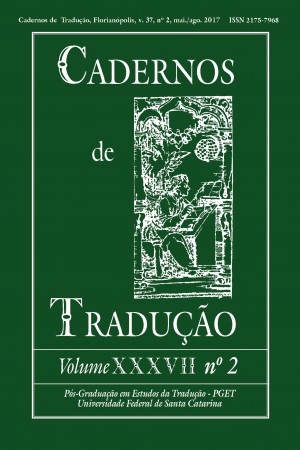The Raven and its flight to the Brazilian sing Language
DOI:
https://doi.org/10.5007/2175-7968.2017v37n2p132Abstract
Poe’s The raven has received several translations since it was first published in 1845, with many translators having already ventured into trying to understand its plot, which centers around a raven and its simple, albeit cold and terrifying, reply to a lonely bereaved lover, in an effort to transpose it into other languages and cultures. Now this enigmatic bird has come to visit the Brazilian deaf culture. This article discusses some strategies used in my translation of the poem into LIBRAS (Brazilian Sign Language)
References
BAUMAN, L. Redesigning literature: the cinematic poets of American Sign Language poetry. Sign Language Studies. Vol. 4, Nº. 1 Fall, 2003.
D'ANDRADE, R.G. The Development of Cognitive Anthropology. Cambridge: Cambridge University Press, 1995.
HUDSON, R. A. Sociolinguistics. 2nd edn. Cambridge: Cambridge University Press, 1996.
KLIMA, E.; BELLUGI, U. The Signs of Language. Cambridge, Mass: Harvard University Press, 1979.
KÖVECSES, Z. Metaphor in Culture: universality and variation. New York: Cambridge University Press, 2005.
KÖVECSES, Z. Metaphor, Language, and Culture. São Paulo: Documentação de Estudos em Linguística Teórica e Aplicada - D.E.L.T.A., 26: especial, pp. 739-757. 2010.
LAKOFF, G.; JOHNSON, M. Metaphors We Live by. Chicago: University of Chicago Press, 2003.
LAKOFF, G.; JOHNSON, M. Philosophy in the Flesh: The Embodied Mind and Its Challenge to Western Thought. New York: Basic Books, 1999.
LYONS, J. Linguagem e Linguística: uma introdução. Rio de Janeiro: LTC, 1987.
NORD, C. Text Analysis in Translation: Theory, Methodology, and Didactic Application of a Model for Translation-Oriented Text Analysis. Amsterdam: Rodopi, 1991.
POE, E. A., The Raven. Disponível em < http://www.poetryfoundation.org/poem/178713 > Acesso em: 26 de maio de 2015.
QUADROS, R. M.; KARNOPP, L. B. Língua brasileira de sinais: estudos linguísticos. Porto Alegre: Artmed, 2004.
REIß, K. Type and individuality of text: decision marking in translation. Translated by Susan Kitron. In: VENUTI, L., (ed). The translation studies reader. New York, NY: Routledge, 2000.
SHORE, B. Culture in mind: Cognition, Culture, and the Problem of Meaning. New York: Oxford University Press, 1996.
STRAUSS, C.; QUINN, N. A. Cognitive Theory of Cultural Meaning. Publications of the Society for Psychological Anthropology. Nº. 9. Cambridge: Cambridge University Press. Available from: Cambridge Books Online. Disponível em: < http://dx.doi.org/10.1017/CBO9781139167000 > Acesso em 16 de fevereiro de 2016.
SUTTON-SPENCE, R.; QUADROS, R. M. Poesia em línguas de sinais: traços da identidade surda. In: QUADROS, R. M.(Org). Estudos Surdos I. Perópolis, RJ: Arara Azul, 2006.
VERMEER, H. J. Skopos and commission in translation action. In: VENUTI, L., (ed). The translation studies reader. New York, NY: Routledge, 2000.
WITHERSPOON, G. Language and Art in the Navajo Universe. Ann Arbor: University of Michigan Press, 1977.
Downloads
Published
How to Cite
Issue
Section
License
Copyright Notice
Authors hold the copyright and grant the journal the right for their articles' first publication, being their works simultaneously licensed under the Creative Commons Attribution License (CC BY), which allows the sharing of such works with its authorship acknowledged and its initial publication in this journal.
Authors are allowed to enter into separate additional contractual arrangements for the non-exclusive distribution of the journal's published version of the work (e.g., post it to an institutional repository or as a book chapter, with an acknowledgment of its initial publication in this journal).






















































